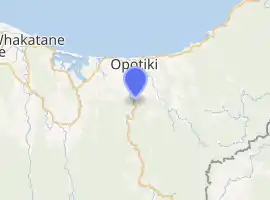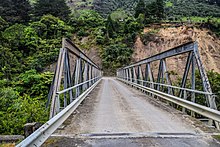Waioeka
Waioeka is a rural community in the Ōpōtiki District and Bay of Plenty Region of New Zealand's North Island.
Waioeka | |
|---|---|
Locality | |

| |
| Coordinates: | |
| Country | New Zealand |
| Region | Bay of Plenty |
| Territorial authority | Ōpōtiki District |
| Ward | Waioeka/Waiota |
| Postcode(s) | 3197 |
Demographics
| Year | Pop. | ±% p.a. |
|---|---|---|
| 2006 | 300 | — |
| 2013 | 294 | −0.29% |
| 2018 | 330 | +2.34% |
| Source: [1] | ||

The statistical area of Oponae, which at 1,255 square kilometres is much larger than this community, had a population of 330 at the 2018 New Zealand census, an increase of 36 people (12.2%) since the 2013 census, and an increase of 30 people (10.0%) since the 2006 census. There were 93 households. There were 165 males and 168 females, giving a sex ratio of 0.98 males per female. The median age was 35.1 years (compared with 37.4 years nationally), with 90 people (27.3%) aged under 15 years, 57 (17.3%) aged 15 to 29, 144 (43.6%) aged 30 to 64, and 39 (11.8%) aged 65 or older.
Ethnicities were 49.1% European/Pākehā, 60.0% Māori, 2.7% Pacific peoples, 0.9% Asian, and 0.9% other ethnicities (totals add to more than 100% since people could identify with multiple ethnicities).
The proportion of people born overseas was 7.3%, compared with 27.1% nationally.
Although some people objected to giving their religion, 34.5% had no religion, 28.2% were Christian and 28.2% had other religions.
Of those at least 15 years old, 30 (12.5%) people had a bachelor or higher degree, and 69 (28.8%) people had no formal qualifications. The median income was $19,900, compared with $31,800 nationally. The employment status of those at least 15 was that 90 (37.5%) people were employed full-time, 42 (17.5%) were part-time, and 24 (10.0%) were unemployed.[1]
Marae
The local marae is known variously as Ōpeke Marae, Opekerau Marae or Waioeka Marae. It is the traditional tribal meeting place of the Whakatōhea hapū Ngāti Irapuaia / Ngāti Ira.[2] The meeting house is called Irapuaia.[3]
Education
Te Kura Kaupapa Māori o Waioweka is a co-educational Māori language immersion state primary school for Year 1 to 8 students,[4] with a roll of 63 as of March 2020.[5][6]
References
- "Statistical area 1 dataset for 2018 Census". Statistics New Zealand. March 2020. Oponae (204600). 2018 Census place summary: Oponae
- "Te Kāhui Māngai directory". tkm.govt.nz. Te Puni Kōkiri.
- "Māori Maps". maorimaps.com. Te Potiki National Trust.
- "Te Kura Kaupapa Māori o Waioweka Ministry of Education School Profile". educationcounts.govt.nz. Ministry of Education.
- "New Zealand Schools Directory". New Zealand Ministry of Education. Retrieved 26 April 2020.
- "Te Kura Kaupapa Māori o Waioweka Education Review Office Report". ero.govt.nz. Education Review Office.
